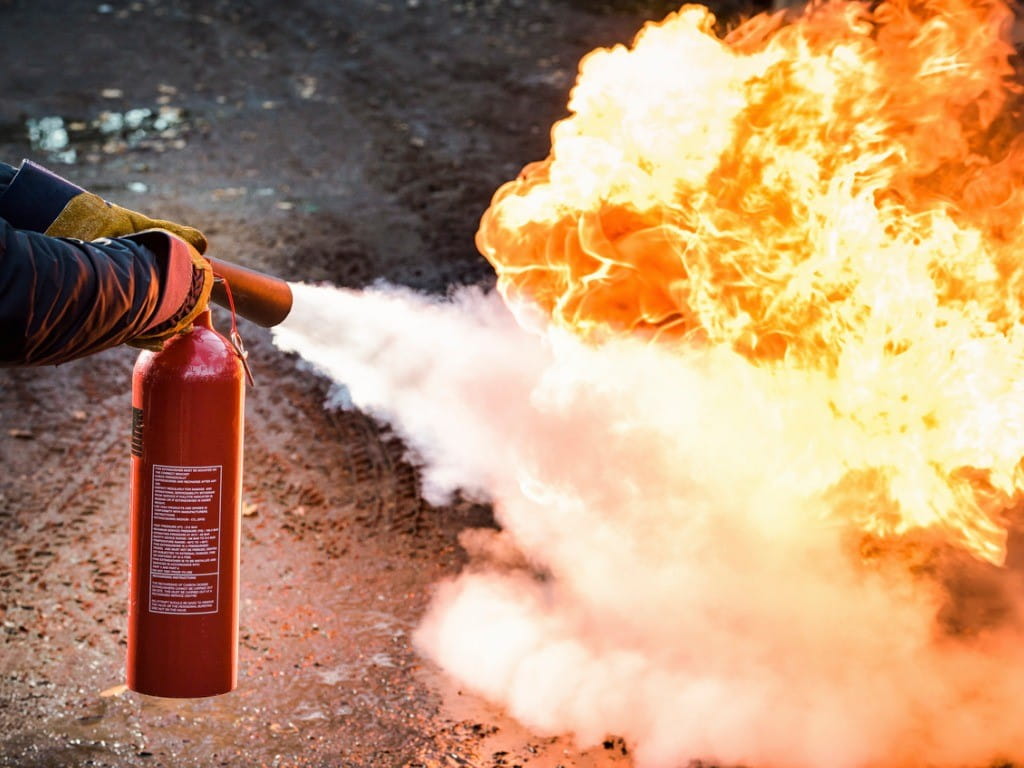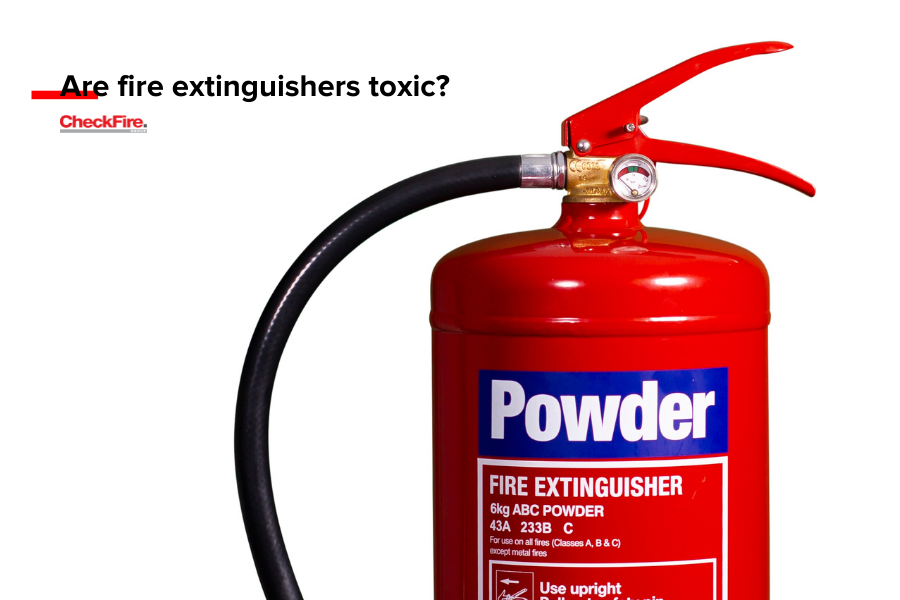Dry powder fire extinguishers are not typically toxic. However, inhalation of the powder can cause respiratory irritation.
Dry powder fire extinguishers are essential safety tools found in homes, offices, and vehicles. These extinguishers effectively combat various types of fires, including electrical and flammable liquid fires. Composed mainly of chemicals like monoammonium phosphate and sodium bicarbonate, they quickly smother flames by interrupting the chemical reaction.
Though not highly toxic, the powder can cause respiratory issues if inhaled. Users should avoid direct inhalation and ensure proper ventilation during and after use. Understanding the components and safety measures of dry powder fire extinguishers helps in effectively and safely managing fire emergencies. Always follow the manufacturer’s guidelines for safe operation.

Introduction To Dry Powder Fire Extinguishers
Dry powder fire extinguishers are essential safety tools. They help put out fires quickly and effectively. These extinguishers use a special powder to fight flames. The powder works by cutting off the oxygen supply to the fire. This method is effective for various types of fires.
Types
There are different types of dry powder fire extinguishers. Each type is designed for specific kinds of fires.
- Class A, B, C Extinguishers: These are multi-purpose. They work on ordinary combustibles, flammable liquids, and electrical fires.
- Class D Extinguishers: These are for metal fires. They are used in industrial settings.
- Specialized Dry Powder: These are for specific chemical fires. They are less common but vital in certain industries.
Common Uses
Dry powder fire extinguishers are used in many places. They are versatile and handle different fire types.
| Location | Reason |
|---|---|
| Homes | For general fire safety |
| Offices | For electrical and paper fires |
| Factories | For industrial fires, including metal fires |
| Vehicles | For fuel and engine fires |
Dry powder extinguishers are effective and versatile. They are a crucial part of fire safety in various settings.
Composition Of Dry Powder Extinguishers
Dry powder fire extinguishers are essential for safety. They use chemical agents to put out fires. Understanding their composition helps in knowing their effectiveness and safety.
Chemical Ingredients
Dry powder extinguishers contain different chemicals. The most common agents are monoammonium phosphate and sodium bicarbonate. These chemicals are non-toxic but can cause irritation.
| Chemical | Function |
|---|---|
| Monoammonium Phosphate | Smothers Class A, B, and C fires |
| Sodium Bicarbonate | Effective on Class B and C fires |
Other ingredients include potassium bicarbonate and calcium carbonate. These chemicals help in putting out specific types of fires.
How It Works
Dry powder extinguishers work by interrupting the chemical reaction of a fire. The powder forms a barrier between the fuel and the oxygen.
- The powder is expelled from the extinguisher.
- It covers the burning material.
- The fire’s chemical reaction stops.
The powder also absorbs heat. This reduces the fire’s temperature, helping to put it out.
Dry powder extinguishers are effective on Class A, Class B, and Class C fires. They are versatile and widely used in homes and offices.
Potential Health Risks
Dry powder fire extinguishers are effective at putting out fires. Yet, they pose potential health risks to users. Understanding these risks can help in handling them safely.
Inhalation Dangers
Inhaling dry powder can cause respiratory issues. Symptoms may include:
- Coughing
- Shortness of breath
- Throat irritation
Prolonged exposure might lead to more serious conditions. These conditions can include lung inflammation. Always use protective masks when using these extinguishers.
Skin And Eye Contact
Contact with the skin can cause irritation. Symptoms may include redness and itching. Washing the skin with water can reduce irritation.
Eye contact with dry powder can be more harmful. It can cause severe irritation and redness. Flush the eyes with water if exposed.
Always wear protective gear to minimize contact risks.
| Exposure Type | Potential Symptoms | Immediate Action |
|---|---|---|
| Inhalation | Coughing, Shortness of breath | Move to fresh air |
| Skin Contact | Redness, Itching | Wash with water |
| Eye Contact | Severe irritation, Redness | Flush with water |
Comparing Toxicity With Other Extinguishers
Comparing the toxicity of dry powder fire extinguishers with other types is essential. Each extinguisher has unique properties and potential health impacts. Knowing these can help you make safer choices. Here’s a detailed comparison of dry powder extinguishers with CO2 and foam extinguishers.
Co2 Extinguishers
CO2 extinguishers are common in electrical fire situations. They use carbon dioxide gas to displace oxygen, smothering the fire.
- Toxicity Level: Low
- Main Concern: Inhalation of CO2 can cause breathing issues.
CO2 is generally safe but can displace oxygen in small spaces. This may lead to suffocation if used improperly. Always ensure proper ventilation when using CO2 extinguishers.
Foam Extinguishers
Foam extinguishers are effective on liquid fires. They form a barrier over the liquid, cutting off the fire’s oxygen supply.
- Toxicity Level: Moderate
- Main Concern: Skin and eye irritation.
Foam extinguishers can cause skin irritation if touched. Eye contact may also lead to irritation. Avoid direct contact and wash thoroughly if exposed.
| Extinguisher Type | Toxicity Level | Main Concern |
|---|---|---|
| Dry Powder | Moderate | Respiratory irritation |
| CO2 | Low | Breathing issues |
| Foam | Moderate | Skin and eye irritation |
Safe Handling Practices
Understanding the safe handling practices of dry powder fire extinguishers is crucial. These practices ensure safety and effectiveness in emergencies. Let’s explore some essential guidelines.
Proper Use
Using a dry powder fire extinguisher correctly is key to safety. Follow these steps:
- Remove the safety pin to unlock the extinguisher.
- Aim the nozzle at the base of the fire.
- Squeeze the handle to release the powder.
- Sweep side to side to cover the fire area.
Always aim low and ensure the fire is completely out before stopping.
Maintenance And Storage
Proper maintenance and storage extend the life of your fire extinguisher. Follow these tips:
- Inspect regularly for any damage or leaks.
- Check the pressure gauge monthly to ensure it’s in the green zone.
- Keep the extinguisher in an accessible location, away from direct sunlight and moisture.
- Store away from heat sources to prevent pressure build-up.
Schedule annual professional inspections to keep your extinguisher in top condition.

Emergency Response If Exposed
Dry powder fire extinguishers are common in many places. They are effective against different fires. But, is dry powder fire extinguisher toxic? Exposure to the chemicals can cause health issues. Knowing the right emergency response is vital.
First Aid Measures
Inhalation: Move to fresh air immediately. Try to breathe slowly and deeply.
- Stay calm and avoid panicking.
- Seek fresh air as soon as possible.
Skin Contact: Wash the area with soap and water. Remove any contaminated clothing.
- Rinse the skin with plenty of water.
- Use soap to clean thoroughly.
- Take off any contaminated clothes.
Eye Contact: Rinse eyes with clean water for 15 minutes. Do not rub eyes.
- Use lukewarm water for rinsing.
- Keep your eyes open during rinsing.
Ingestion: Drink water to dilute the substance. Do not induce vomiting.
- Rinse mouth with clean water.
- Drink small sips of water slowly.
When To Seek Medical Help
Inhalation: Seek medical help if breathing becomes difficult.
- Look for symptoms like wheezing or shortness of breath.
Skin Contact: Consult a doctor if irritation or redness persists.
- Watch for persistent itching or redness.
Eye Contact: Get medical help if vision becomes blurry or painful.
- Note any changes in vision or eye pain.
Ingestion: Seek immediate medical attention if you feel unwell.
- Observe for symptoms like nausea or stomach pain.
Knowing these steps can help in an emergency. Always prioritize safety first.
Environmental Impact
Dry powder fire extinguishers are common in many places. These extinguishers are effective against fires. But, they may affect the environment. Let’s explore their environmental impact.
Disposal Concerns
Disposing of dry powder fire extinguishers can be tricky. They contain chemicals that might harm the earth. These chemicals can seep into the soil and water.
Improper disposal can lead to pollution. It’s important to follow guidelines for safe disposal. Many local waste facilities accept these extinguishers. Make sure to check the rules in your area.
Eco-friendly Alternatives
There are eco-friendly options available. Water-based extinguishers are one choice. They use water to put out fires. This method is safer for the environment.
Foam extinguishers are another option. They are effective and less harmful. Look for products marked as environmentally friendly. This helps reduce the impact on the earth.
| Extinguisher Type | Environmental Impact |
|---|---|
| Dry Powder | Potentially Harmful |
| Water-Based | Eco-Friendly |
| Foam | Less Harmful |
- Choose eco-friendly fire extinguishers.
- Follow disposal guidelines.
- Check local waste facilities.
Frequently Asked Questions
Is Dry Powder Fire Extinguisher Safe?
Dry powder fire extinguishers are generally safe. However, inhaling the powder can cause respiratory irritation. Use caution.
Can Dry Powder Fire Extinguisher Cause Health Issues?
Inhaling dry powder can cause coughing and breathing difficulties. Avoid direct exposure and ventilate the area after use.
What Are The Risks Of Using Dry Powder?
The main risks are respiratory irritation and skin dryness. Always wear protective gear when using a dry powder fire extinguisher.
Conclusion
Understanding the safety of dry powder fire extinguishers is essential. They are generally non-toxic but can irritate. Always use proper safety measures. Ensure proper ventilation and avoid inhalation. Regular maintenance and awareness can keep you safe. Stay informed and prioritize safety in fire prevention efforts.

